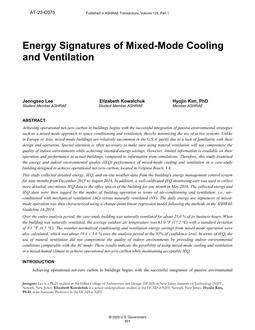
C075 — Energy Signatures of Mixed-Mode Cooling and Ventilation
- Comments Off on C075 — Energy Signatures of Mixed-Mode Cooling and Ventilation
- ASHRAE
Click here to purchase
Achieving operational net-zero carbon in buildings begins with the successful integration of passive environmental strategies such as a mixed-mode approach to space conditioning and ventilation, thereby minimizing the use of active systems. Unlike in Europe or Asia, mixed-mode buildings are relatively uncommon in the U.S.A. partly due to a lack of familiarity with their design and operation. Special attention is often necessary to make sure using natural ventilation will not compromise the quality of indoor environments while achieving intended energy savings. However, limited information is available on their operation and performance in actual buildings, compared to information from simulations. Therefore, this study examined the energy and indoor environmental quality (IEQ) performance of mixed-mode cooling and ventilation in a case-study building designed to achieve operational net-zero carbon, located in Virginia Beach, VA. This study collected detailed energy, IEQ, and on-site weather data from the building’s energy management control system for nine months from December 2015 to August 2016. In addition, a well-calibrated IEQ monitoring cart was used to collect more detailed, one-minute IEQ data in the office spaces of the building for one month in May 2016. The collected energy and IEQ data were then tagged by the modes of building operation in terms of air-conditioning and ventilation: i.e., air-conditioned with mechanical ventilation (AC) versus naturally ventilated (NV). The daily energy use signatures of mixed-mode operation was then characterized using a change-point linear regression model following the methods in the ASHRAE Guideline 14-2014. Over the entire analysis period, the case-study building was naturally ventilated for about 25.0 % of its business hours. When the building was naturally ventilated, the average outdoor air temperature was 63.0 °F (17.2 °C) with a standard deviation of 8.1 °F (4.5 °C). The weather-normalized conditioning and ventilation energy savings from mixed-mode operation were also calculated, which was about 19.4 ± 3.0 % over the analysis period at the 95% of confidence level. In terms of IEQ, the use of natural ventilation did not compromise the quality of indoor environments by providing indoor environmental conditions comparable with the AC mode. These results indicate the possibility of using mixed-mode cooling and ventilation in a mixed-humid climate to achieve operational net-zero carbon while maintaining acceptable IEQ.
Product Details
- Published:
- 2023
- Number of Pages:
- 10
- Units of Measure:
- Dual
- File Size:
- 1 file , 4.5 MB
- Product Code(s):
- D-AT-23-C075
- Note:
- This product is unavailable in Russia, Belarus

